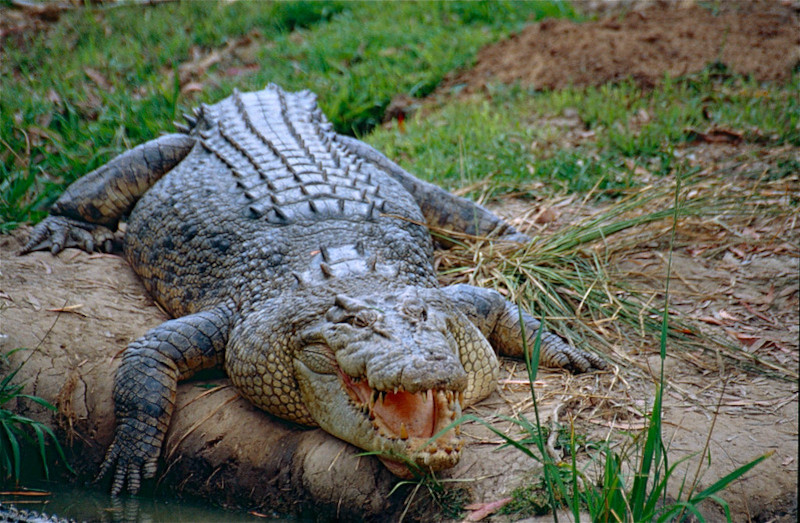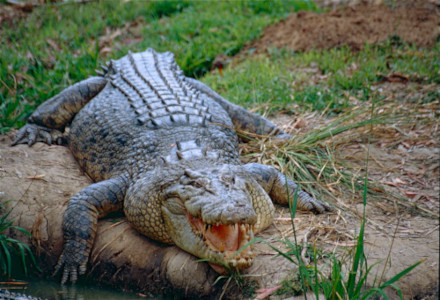
Saltwater Crocodile Facts
- This magnificent work of Nature and evolution most frequently goes by its informative common name of the Saltwater Crocodile. That term, however accurate, isn’t the only name applied to it, however. In point of fact, several others are sometimes used.
- The alternate names themselves also often provide clues to its nature. These include such terms as the Indo-Pacific crocodile, esturarine crocodile, sea crocodile, and marine crocodile. The animal’s also sometimes informally referred to as the saltie.
- Professional researchers, meanwhile, typically refer to the creature by its scientific name. That’s the technical name of Crocodylus porosus. Regardless of which name one chooses to use when referring to it, though, it’s an especially impressive crocodilian.
- The renowned German naturalist Johann Gottlob Theanenus Schneider made the first formal recognition of the reptile. The well known researcher acknowledged this incredible example of evolution as a separate and distinct species in the year 1801.
- The animal appears, for the moment, at least, to be maintiaing a population base that’s both stable and sufficient. That further seems to hold true throughout the entirety of its range. The IUCN therefore, presently lists the reptile as Least Concern on its Red List.
- The amazing Saltwater Crocodile nevertheless faces dangers that could potentially threaten it in the future. Habitat loss poses a potential threat, due to human expansion. The ongoing process of climate change, however, likely condstitutes its greatest threat.
Related Articles
Saltwater Crocodile Physical Description
Sheer size alone isn’t the only trait of the Saltwater Crocodile that impresses those who view the creature. That characteristic nonetheless certainly does bear mentioning. That’s because this species presently constitutes the largest of all currently known crocodilians.
The species also, like many of its relatives, displays a degree of the physiological characteristic of sexual dimorphism. In its specific case, though, this ranks as particularly severe. That’s due to the fact that the males attain a length roughly twice that of females.
The significantly longer males reach an average legnth measuring about 20 ft (6 m). Exceptional specimens, however, sometimes attain lengths of as much as 23 ft (7 m). The males further reach a weight that averages approximately 1,000 lbs (453.6 kg).
Females of the species, meanwhile, only attain an average length measuring approximately 10 ft (3 m). Even the exceptional individuals rarely exceed this by much. Sheer mass, however, remains starkly contrasted, with females rarely exceeding 330 lb (150 kg)!
While rare indivuals exceed these weights in both genders, the two sexes remain otherwise virtually indistinguishable in simple appearance. Its snout also develops wider than most related species. A pair of ridges also extends the length of the snout, from the eyes.
The body of the Saltwater Crocodile further differs from most others in its girth. Its body develops as much stouter in form. In coloring, most adults manifest a dark, greenish-drab shade. A few light gray or tan areas sometimes appear, however, in various spots.
- Kingdom: Animalia
- Phylum: Chordata
- Class: Reptilia
- Order: Crocodilia
- Family: Crocodylidae
- Genus: Crocodylus
- Species: C. porosus
Saltwater Crocodile Distribution, Habitat, and Ecology
Fortunately, the remarkable Saltwater Crocodile evolved as native to a comparatively broad swathe of the globe. Interestingly, furthermore, that range roughly straddles the equator. It further does so, by random chance, almost equally across both hemispheres.
This animal appears as far north as the eastern coast of the country of India. From there, its range extends through Sri Lanka, Bangladesh, Myanmar, Thailand, Malaysia, Cambodia, and Vietnam, to name a few. That range extends as far south as northern Australia.
Wherever it makes an appearance, though, it displays highly specific preferences in terms of habitat. That’s because the remarkable crocodilian makes its home solely along the coastline. Individuals do, however, occasionally swim far out to sea, outside their range.
Most specimens spend the vast majority of their time inhabiting very specific habitat types. These principally consist of river deltas and mangrove swamps. In some regions, the incredible animal also migrate to warmer parts of its range during the local winter season.
The Saltwater Crocodile also differs from most of its kin in yet another manner. Although most crocodilains live as social creatures, this species mainly lives a solitary life. Most individuals, especially the males, further exhibit extremely strong territorial drives.
It also spends much of its time in a lethargic state. This allows it to survive for months at a time without feeding. When it does feed, however, it does so strictly as a carnivore, like other crocodiles. It further represents an apex predator throughout most areas of its range.
Species Sharing Its Range
Check out our other articles on 6 Laudably Luscious Lilies, Black-and-white hawk-eagle, Baatara gorge waterfall, Dwarf Crested Iris, Giant Otter, Malaysian Dead Leaf Mantis

